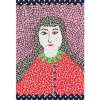Book
To Read At Night
Yayoi Kusama’s 2004 Book To Read At Night, comprises five screen-prints. Each is covered by Kusama’s Nets pattern and contains an eye, open book, the text ‘LOVE FOREVER’, and a small diagram. This enigmatic array references Yayoi Kusama's deep-seated spiritualism as well as her seminal 1998-99 retrospective exhibition at New York's MoMA.
Yayoi Kusama Book To Read At Night For sale
Book To Read At Night Value (5 Years)
With £26734 in the past 12 months, Yayoi Kusama's Book To Read At Night series is one of the most actively traded in the market. Prices have varied significantly – from £398 to £21111 – driven by fluctuations in factors like condition, provenance, and market timing. Over the past 12 months, the average selling price was £8911, with an average annual growth rate of 17.33% across the series.
Book To Read At Night Market value
Auction Results
| Artwork | Auction Date | Auction House | Return to Seller | Hammer Price | Buyer Paid |
|---|---|---|---|---|---|
 Book To Read At Night A Yayoi Kusama Signed Print | 29 Nov 2024 | Mainichi Auction, Osaka | £6,375 | £7,500 | £9,000 |
 Book To Read At Night C Yayoi Kusama Signed Print | 25 Oct 2024 | SBI Art Auction | £5,950 | £7,000 | £8,500 |
 Book To Read At Night D Yayoi Kusama Signed Print | 28 Jan 2024 | SBI Art Auction | £9,775 | £11,500 | £13,500 |
 Book To Read At Night B Yayoi Kusama Signed Print | 28 Oct 2023 | SBI Art Auction | £9,775 | £11,500 | £13,500 |
 Book To Read At Night E Yayoi Kusama Signed Print | 28 Oct 2022 | SBI Art Auction | £9,350 | £11,000 | £13,000 |
Sell Your Art
with Us
with Us
Join Our Network of Collectors. Buy, Sell and Track Demand
Meaning & Analysis
Yayoi Kusama’s 2004 series, Book To Read At Night, comprises five screenprints in varying colourways. Each is enmeshed by Kusama’s iconic Infinity Nets pattern, and containing an eye, an open book, the text ‘LOVE FOREVER’, and a small, abstract diagram. Each element possesses a mystical, surreal quality, that is largely enigmatic; the eye motif, however, was dominant in Kusama’s works around 2004, and is the most clearly decipherable element.
The eye, which is always depicted wide-open by Kusama, references the artist’s history of hallucinations, which started as a child with terrifying visions of bright lights, polka dots and other obliterating patterns. These experiences were at once traumatic and eye-opening, leading Kusama to a spiritual revelation that has dominated her oeuvre since: she recounts, ‘I saw the entire room, my entire body, and the entire universe covered with red flowers, and in that instant my soul was obliterated, and I was restored, returned to infinity, to eternal time and absolute space. This was not an illusion but reality itself.’ Thus, the eye signifies her spiritual awakening.
The series also makes reference to Yayoi Kusama’s seminal retrospective at the Museum of Modern Art (MoMA) in New York, in 1998-99, which was entitled ‘Love Forever.’ This nod to Kusama’s touring retrospective implicitly acknowledges the significance of this landmark moment in the artist’s career, and her secure place in the contemporary art canon.












